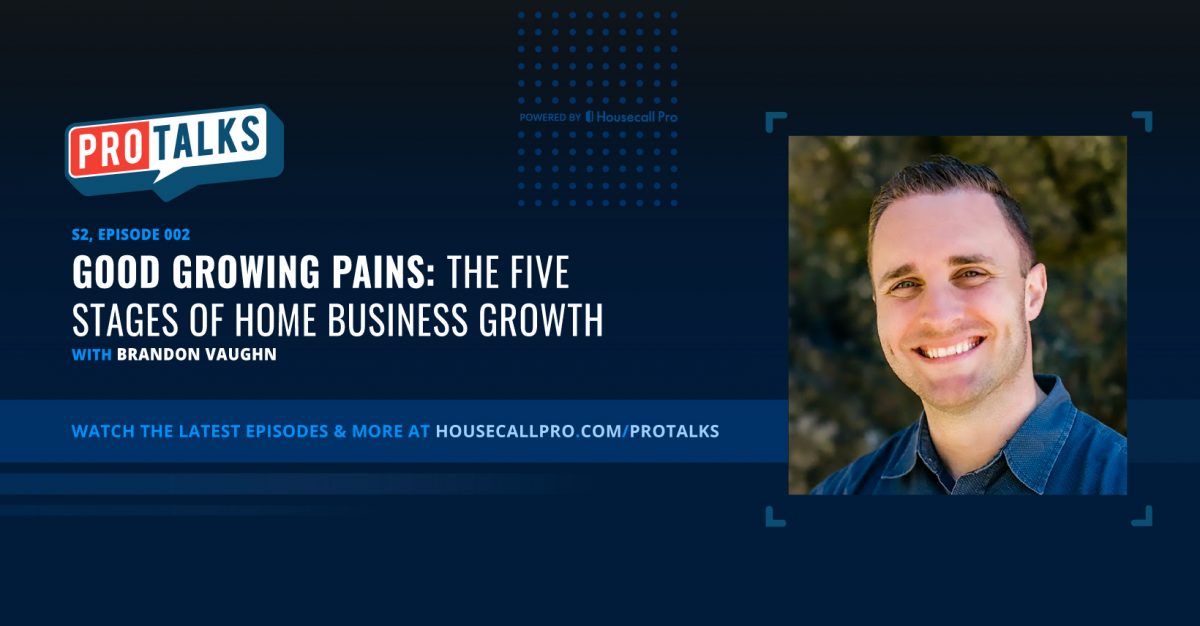
Brandon Vaughn is the owner of All-Clean SoftWash which he grew to over $500K a month in less than six seasons. He’s also CEO of CONQUER, an educational platform for pros.
In this episode of the ProTalks Podcast, Brandon explains what he sees are the five stages a home service business goes through as they scale from a one-person operation to a multi-million dollar company. These stages are where business owners have to take “key, big leaps of faith,” as Brandon explains it. And they often feel like you’ve entered a new stage.
We’ve outlined the stages as he describes them below. Stream the episode to see Brandon’s organizational charts in each stage, along with other great tips on hiring, scaling, and managing your business.
The five stages of business growth
Stage one: the field [13:09]
In stage one, you’re an owner/operator working in the field. You may even have a second crew in the works, but you’re still the lead technician out on jobs.
“You’re the one that’s primarily going out and providing those services that you actually are charging for. And it really gets you to a bottleneck to where there’s only so much that you can do out in the field until you start running into what I call the ‘symptoms of needed growth.’ So your business actually will tell you when it’s time to grow,” Brandon explains.
Pain points that tell you it’s time to move to the next stage:
- You’re working long hours.
- You’re booked out for more than a couple of weeks and customers are waiting for availability.
- You can’t keep up with all the quotes and the calls and things are slipping through the cracks.
- It’s difficult to juggle service calls along with sales and marketing.
How to get to stage two:
“For you to get into stage two, your first systems you really got to work on are some of your training systems to make sure that your production people are delivering quality, consistent work without you being a helicopter parent out in the field making sure they’re doing the job right,” Brandon explains.
Stage two: the office [20:16]
You’re now spending the majority of your time in the office and are doing the majority of the administrative work while your crews are out there in the field handling jobs.
Brandon explained that moving to stage two is often the scariest leap for business owners that are used to being in control of every job. But the benefit of getting out of the field is time. You can now work on growing your business and even spend more time with your family.
Pain paints that tell you it’s time for the next stage:
- You’re working long hours again.
- It’s hard to keep up with all of the quotes and calls
- You’re missing phone calls and your customer service is not at its best.
How to get to stage three:
To get to stage three, you need to hire your first non-revenue generating employee which might be an office manager or a production manager that oversees the crew leads.
Stage three: sales [30:50]
You’re now primarily focusing on sales and marketing. You’re no longer the person answering the phones or constantly dealing with the technicians. You have your systems in place and crew leaders to take the lead.
This was one of the scariest hires for Brandon because it required paying someone who wasn’t directly bringing money back into the business. But he explains that hiring someone to help with the operations, such as answering the phones and following up with customers and making sure the crews are where they need to be — this allows you to focus on networking and closing bigger projects and growing your brand.
“A good employee is never a liability in your company,” Brandon explains. “They’re always an asset. They don’t cost you anything. They really don’t. They will always make you money. If they’re a good employee, you’re not hiring them too soon, they’re needed in the business. They will always bring an ROI back into your company … And this really allows you to get from that $500,000 to the $1.5 million, maybe a little bit more, where you have an office manager and you have a production manager.”
Pain Point that tells you it’s time for the next stage:
- You are crushing it at sales and bringing in new leads and bigger projects, but your teams can’t keep up. Your sales and marketing is a step ahead of the rest of your operation.
How to get to stage four:
You hire someone to manage the sales and marketing, and you focus on managing the business.
Stage four: general manager [38:00]
In stage four, you have managers that take care of the main areas of your business. “They’re owning the marketing side, they’re owning the admin side, they’re owning the production side, and you have someone that’s responsible for making sure that the sales come in and generate that revenue.”
Brandon explains that this is the stage where you’ll see the biggest leap in your growth, and much of it has to do with handing over sales to a trained salesperson or sales team. “When I hired my first salesperson and he sold $45,000 worth of work his first week that he was working for me. I was like, ‘I can grow this thing now.’ It finally clicked for me that this is how you do it. This is how you grow the business.”
How to know it’s time for the next stage:
- You’re ready to take a step back and let someone else manage the company while you reap the benefits and fine-tune your brand.
How to get to stage five:
To get to stage five, it’s time to turn over the daily responsibilities to a direct report.
Stage five: the owner [48:37]
“You’re a business owner and you can step away and leave for months on end. And you can have quarterly meetings with your general manager, but you have someone that really has ownership,” Brandon explains.
In this stage, there’s one person who reports to you. They may be a CEO-type figure that has equity ownership or a profit share ownership in the business. Or you may have a number of general managers when you have multiple locations.
“When I hired my first general manager to kind of watch one single location,” Brandon explains, “I really quickly realized, ‘Oh my gosh, I can have a whole bunch of general managers and we could really scale this out.’ It just becomes a matter of duplicating and replicating, and this is really where you can get the $3 million plus business.”
The dilemma of seasonality [41:36]
A lot of the trades that do much better during certain seasons have an issue scaling their business because of it. Brandon and Roland provided three recommendations for handling this.
1. Have systems and processes in place to mitigate slow seasons and be prepared to bounce back.
2. Market heavily during the slow times.
3. Promote recurring service plans or VIP memberships.
“Don’t pull off the pedal because that’s going to let you hire that and keep that other production crew running beyond the period of which it’s busy, which I feel evens out that curve a little bit,” Roland explains.
Listen to the full episode for more tips on tackling seasonal downturns, what kinds of roles are ideal for your business model, and more.
More resources from Brandon Vaughn
Enjoy this episode? Brandon’s a frequent guest of Housecall Pro’s educational resources. For more tips from Brandon, also check out:
Dealing with Customers and Using PR Opportunities
Hiring Landmines to Watch Out for in a Recession Economy



